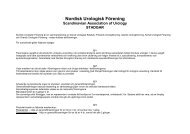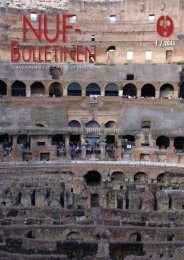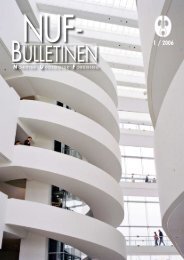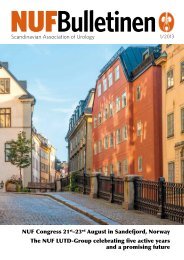Nordisk Urologisk Forening - Scandinavian Association of Urology
Nordisk Urologisk Forening - Scandinavian Association of Urology
Nordisk Urologisk Forening - Scandinavian Association of Urology
You also want an ePaper? Increase the reach of your titles
YUMPU automatically turns print PDFs into web optimized ePapers that Google loves.
Rapport fra nuf 2007<br />
Redigeret af Peder Graversen og Hans Jørgen Kirkeby<br />
I det følgende findes en rapport, som<br />
i ord og billeder skal forsøge at fange<br />
indhold og stemning ved NUF-kongressen<br />
i Århus. Redaktørerne har efter<br />
kongressen kontaktet moderatorer<br />
ved sessionerne og bedt disse om at udfærdige<br />
korte resumeer, hvilket de velvilligt<br />
har gjort. I artiklen er forfatteren<br />
til resumeerne efterfølgende anført i<br />
parentes. To emner, nemlig ”palliation<br />
ved prostatacancer” og ”behandling af<br />
kryptorkisme” gennemgås mere detaljeret<br />
i 2 artikler i herværende udgave af<br />
NUF-Bulletinen.<br />
ONSDAG DEN 13 . JUNI – State<br />
<strong>of</strong> art: Vitamin D and the natural<br />
history <strong>of</strong> prostate cancer<br />
Gary G Schwartz - Pr<strong>of</strong>essor at departments<br />
<strong>of</strong> Cancer Biology and Epidemiology<br />
and Prevention, Wake Forest University,<br />
Winston-Salem, NC, USA is one<br />
<strong>of</strong> the Vitamin D and prostate cancer<br />
pioneers, who more than fifteen years<br />
ago rose the ‘‘the vitamin D hypothesis’’<br />
having recognised that prostate cancer<br />
risk was inversely associated with sun<br />
exposure in the United States.<br />
The result <strong>of</strong> two related discoveries<br />
has currently experiencing an enormous<br />
renaissance in interest in vitamin<br />
D: the first is the recognition that beside<br />
its ‘‘classical’’ role in regulating mineral<br />
homeostasis, the hormonal form <strong>of</strong> vitamin<br />
D controls the differentiation and<br />
proliferation <strong>of</strong> many cell types that<br />
possess vitamin D receptors (VDRs).<br />
The second is that many non-classical<br />
cells, such as prostate cells, synthesize<br />
the vitamin D hormone from its prohormone,<br />
the serum levels <strong>of</strong> which are<br />
largely determined by exposure to sunlight.<br />
These discoveries suggest that<br />
sunlight may play key roles in the natural<br />
history <strong>of</strong> many cancers, in processes<br />
ranging from cancer prevention to<br />
survival.<br />
To understand how sunlight/vitamin<br />
D could prevent cancer, it is important<br />
to recall the synthesis <strong>of</strong> vitamin D metabolites.<br />
The synthesis <strong>of</strong> 1,25(OH)2D<br />
begins with the production <strong>of</strong> vitamin<br />
D3 after 7-dehydrocholesterol if the<br />
skin is exposed to ultraviolet (UV) radiation.<br />
To become biologically active,<br />
vitamin D undergoes two hydroxylations:<br />
the first occurs in the liver, forming<br />
25-Hydroxyvitamin D (25-OHD), the<br />
prohormone and major circulating form<br />
<strong>of</strong> vitamin D; the second occurs at the<br />
1 a position, forming 1,25(OH)2D, the<br />
hormonal form <strong>of</strong> vitamin D. Until recently,<br />
the synthesis <strong>of</strong> 1,25(OH)2D was<br />
thought to occur exclusively in the kidney.<br />
However, in 1998, Gary Schwartz<br />
and colleagues demonstrated that the<br />
normal prostate hydroxylates 25-OHD<br />
to 1,25(OH)2D, where the hormone<br />
functions locally to control growth<br />
and differentiation. The implications<br />
<strong>of</strong> this discovery for prostate cancer<br />
prevention are pr<strong>of</strong>ound; they imply<br />
that greater sunlight exposure, which<br />
results in higher serum levels <strong>of</strong> 25-<br />
OHD, should result in a greater synthesis<br />
<strong>of</strong> 1,25(OH)2D within prostate cells<br />
and to a reduced risk <strong>of</strong> prostate cancer.<br />
Moreover, we now appreciate that<br />
Lars Grenabo.<br />
Knud Petersen i receptionen på<br />
Kunstmuseet Aros. Pr<strong>of</strong>essor Gary G. Schwartz.<br />
N U F – B u l l e t i n e n • 2 / 2 0 0 7 R appor t fra nuf 2007 11









